|
The Pooch Belly |
|
Ok... I know that the title of
this article alone probably drew the attention of a number of
my female readers. And why shouldn't it? The
"pooch belly" is a common condition nowadays that makes most
women cringe. The pooch
belly refers to that abdominal roll of belly fat right above
the belt line that can often be a challenge to get rid of and
there are a variety of factors that can contribute to the
pooch. Diet, stress, pregnancies, posture, balance, and
exercise, ... all these things can play a role in appearance
or disappearance of the pooch.
Diet - Your diet can
obviously be
a major contributing factor to your abdominal
appearance. However, even if your diet
seems clean, you could still have food
intolerance to certain foods that could tend to bloat your
lower intestines and contribute to the “pooch belly” syndrome.
Wheat gluten is one very common intolerance and tends to
interfere with good digestion thus causing inflammation and
bloating. In order to determine if you have this kind of
food sensitivity, you will need to experiment with foods and
take not of how you feel and look afterwards. This is of
course in addition to the old calories in - calories out
monitoring!
Stress
- When your body is constantly
stressed, losing body fat is extremely difficult. By reducing
your stress level with such things as yoga, tai chi, and qi
gong, you will dramatically improve your mental and physical
wellness. Make sure that you're getting a good amount of
sleep, drink plenty of water, and eat as organic as possible.
Pregnancies
- After pregnancy, the body needs to normalize and
it takes 9 months or more to get back into physiological
balance. This balance is not just hormonally-related but also
related to body weight, proper posture and normal muscle
tension. If all of these things are not in balance, you will
tend to have inflammation that inhibits the inner (muscular)
unit and you will have a higher incidence of abdominal wall
and inner unit dysfunction.
C-sections do not help and can make things more challenging
either. With multiple c-sections the amount of time between
childbirths could also be a factor. If less than two
years, the physical structures which contribute to childbirth
may not have repaired completely before they were asked to do
it again. The net result is weakness and that contributes to
the lack of stabilization.
Posture & Balance
- Visceroptosis is a condition in which the internal organs have been
compressed and displaced by poor posture and the enlarging
womb from pregnancy, and this has a direct effect on inner
unit dysfunction. The displacement of
internal organs can stretch the attachments which hold the
stomach, liver, and kidneys in their proper place in the upper
abdomen. As a result, they are left suspended in a lower
position. This produces a tendency for the inhibition of the
inner unit. It also influences other structures such as
blocking or squeezing of tubular structures, ducts, blood
vessels, and nerves. This can lead to all kinds of problems
such as indigestion, kidney problems and constipation.
The long and short of
all this is that your insides have to be in shape for your
outside to be in shape and that requires exercises that most
people are not doing.
Resistance Exercise -
An exercise program
needs to balance muscles that may have become unbalanced. One
way to do that is to include a lot of body movement on
unstable surfaces such as a swiss ball. Another way is with
special exercises for the inner unit.
The inner unit is a group of deep muscles
that provide the necessary joint stabilization for the spine.
If the inner unit doesn’t activate your spine properly, your
spine, pelvis and joint structures are placed under a lot of
stress and this can lead to orthopedic injuries (and other
dysfunctions like your lower abs “pooching” out, regardless of
body fat levels).
The inner unit consists of the transverse
abdominis, multifidus, the pelvic floor and the diaphragm.
Research has shown that the inner unit muscles operate on a
different neurological loop than other core muscles.
The Transverse
abdominis (TVA) is the deepest, innermost layer of all
abdominal muscles. Think of the TVA muscle as your body's
natural weight-lifting belt. When the TVA contracts, it causes
hoop tension around your mid section like a girdle or corset.
If the TVA muscle does not tighten up and work properly,
acting as a girdle around your waist to stabilize your spine
and pelvis, you are at much higher risk of injury (or
dysfunction, as in a protruding aka "pooching" abdominal
wall!!!)
To activate the TVA,
draw your belly button up and in towards your spine. This
activation should be done before any bending over or reaching
overhead, especially with heavy loads. A little trick is to
get a string and tie it around your waist at the bellybutton
level. Draw your abdomen up and in toward your spine as far
you can, then let it out about three-quarters of the way and
tie the string at that point. It should be tight but really
not noticeable. If your TVA relaxes and extends your abdominal
wall, the string will tighten up and you will immediately get
feedback.
The next inner unit
muscle you have to consider is the multifidus. This muscle
lies deep in the spine spanning three joint segments. The
multifidus provides joint stabilization at each segmental
level. Each vertebra needs stiffness and stability to work
effectively to reduce degeneration of joint structures.
The third set of
inner unit muscles are the pelvic floor muscles. It’s
important for the pelvic floor and the inner unit to work
properly. In many cases, due to operations such as hernias,
hysterectomies and C-sections, the inner unit muscles have
been cut, reducing communication to these muscles. By doing
some very simple, but very important exercises, you can
re-establish communication between the nervous system and the
muscles, tighten and tone the muscles, and prevent or reduce
incontinence, leakage and pelvic dysfunction.
If you’re not
specifically working each of these three inner unit muscles,
plus the diaphragm, your lower abdominal area will not achieve
the strength or muscular look that you’re after. Here
are a few of
these inner unit exercises for you:
• Four point transverse abdominis tuck
• Horse stance series
• Pelvic Tilt
• Heel slides
Click here for the
description of the exercises from tomvenuto.com.
Cardio Exercise - It’s especially easy
for your body to adapt to aerobics. When you do too much
aerobic exercise, your body becomes more energetically
efficient. As you run on the treadmill, it says you burned X
amount of calories, but you’re really expending less energy at
a given workload as you keep getting in better condition than
you used to be.
So the question is, what is the
alternative? One solution is to begin
alternating some of your conventional steady state cardio with
higher intensity interval training. Interval training is very
challenging but very effective, not to mention time efficient
and it’s a good way to break a plateau if your body has
adapted to conventional long duration, steady state cardio.
After your interval
program, then go on to do your regular resistance training for
the entire body or do a simple circuit weight training
program, depending on your goals and amount of time you have.
Resistance training builds muscle and more muscle means you
burn more calories and more body fat. Resistance training also
elevates your metabolism for many hours after a training
session.
Ref: David Grisaffi
-
www.flatten-your-abs.net
|
|
How Many
Calories? |
|
It's no secret that you have to
create and maintain a calorie deficit if you want to burn
fat. With 3,500 calories equating to roughly a pound
of body fat, everyone is looking for a way to pinch 500 -
1000 calories a day to hit that 1 - 2 pound per week goal
through diet and exercise.
But how many calories do you
need? That is the big question that a lot of people
don't understand. There are quite a few methods for
figuring this out... depending on how detailed that you want
to get.
If you just want a general
idea of your calorie need you can just go with the averages.
For fat loss, men typically need 2100-2500 calories per day,
while women need 1400-1800 calories. For maintenance,
men typically need 2700-2900 calories per day, while women
need 2000-2100. These are average numbers and should
be in the ballpark if your body size and activity levels are
average.

You can also get a quick idea
of your calorie need by doing a little bit of math.
For fat loss you want to shoot for 10-12 calories per pound
of bodyweight while maintenance is in the 14-16 calories per
pound range. Your activity level will determine which
number that you use. If you are lightly active you
would use the lower number, moderately active the middle
number, and the higher number for very active.
If you're one of those people
that want to get a very accurate estimate of your calorie
needs and maintenance levels you can use the Harris-Benedict
formula that utilizes your basal metabolic rate (BMR) or the
Katch-Mcardle formula which incorporates your body fat
percentage and lean body mass. I won't bore you with
the complex details but you can click on
this link for additional
information.
So as you are putting
together your game plan for your "lifestyle change" take
your caloric requirements into consideration to ensure that
you are staying on target.
|
|

|
|
|
Elite
Bodyweight Exercise of the Month! |
|
Mountain
Climber / Mountain Jumper
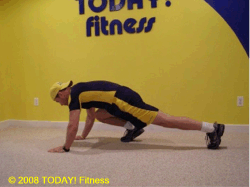
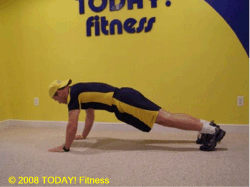
Summary:
Although mountain climber exercises were common in old school
gym classes and track and field practices, many people dismiss
the exercise as just extra work. When performed
properly, the mountain climber can serve as an excellent
dynamic stretching exercise, warm-up, and even cardio.
The mountain climber can be performed as pictured above with
and alternating lunge type pattern, or even by basically
running in place with your hands on the ground depending on
the training effect that you are targeting. The mountain
jumper is another alternative similar exercise that adds an
additional focus on the abdominals.
Target:
abs, legs (rectus abdominis, hamstrings)
Count: 2
Description: For the
mountain climber, begin with your hands on the ground and one
foot forward with the knee close to the chest. Jump your
hips up to allow you to change positions with the alternate
leg. The mountain jumper is basically a squat thrust,
without the squat. Go from a pushup position and jump
your feet forward with your knees near your chest.
|
|
Reach Out and Touch
Someone |
|
Which is exactly what my intension has been with the
website, podcast, YouTube channel, Facebook group, and pretty much
everything that I've done under the TODAY! Fitness umbrella. Since
I don't have to rely on my personal training as my primary source of
income, I get to focus my efforts on helping people by trying to provide
useful information that can help them to better their workouts and
exceed their goals. There's something to be said for the
satisfaction that you get from doing what you love to do : )
I know that many of you may not find this as interesting
as me, but since it's my newsletter, I figured there's nothing you can
do about it (except unsubscribe) so I'll take the time to give you a
quick overview on the TF Stats to date ; )
I created
todayfitness.net at the end of 2005 and
began
The Day After Yesterday eNewsletter in
January 2006. For the todayfitness.net website, the average hits per
month were over 128,000 in May with around 10,000 visits (4,100 hits per
day, 312 visits per day). It's funny when I look at what people
are searching for when they happen upon the site. The top 5
strings have to do with the homemade fitness equipment with chin-up bar,
suspension straps, and kettlebells being the most searched. And
after all that effort that I put into the exercises : ( Email
distribution of the monthly eNewsletter is roughly 350 peeps in addition
to anyone who hits the page directly from the website.
I only started the
TODAY! Fitness Facebook group a few
months ago, but we have roughly 50 members to date and membership has
steadily been increasing. Next step it to get some open dialog on
the group for more blog type discussions.
I currently have 14 videos posted on YouTube under the
user name
TodayFitness and I try to add one or
two
every month. The TodayFitness channel has over 30 YouTube
subscribers and adding more each week. The Ab Circuit video that I posted up there has over
1,500 views in the past year.
The
TODAY! Fitness video podcast that I
recently posted on iTunes a few months ago has been impressive.
It's amazing how much larger the audience gets with this media channel.
Looks like the podcast generated over 7,000 hits in May,
although I still haven't been able to determine the number of
subscribers. Video content is similar to the YouTube channel, but
the audience is HUGE!
Anyhow, that's my update on the latest from TODAY!
Fitness. Part of the reason for this is to give you a heads up
about the other content that I have out there in addition to the
eNewsletter. As always, your comments, questions, feedback, and
suggestions are appreciated... so keep the emails coming. Thanks
for your support!
|
|
It's Tornado
Season |
|
Well, judging by
the comments and searches that have been performed on my
website and videos, there's apparently a decent number of
people that are interested in my homemade fitness equipment
articles. It just goes to show that you don't have to
dump a lot of money into building a gym or purchasing fancy
equipment. Given this level of interest, I figured I'd
take this opportunity to show you my latest creations that
is super easy to make.
If you look in
some of the fitness supply catalogs that sell functional
training equipment, you might have seen an item called a
"tornado ball", "slam ball" or "rope ball". This is
basically a medicine ball with a rope that runs through it
and is very useful for core training. Using a tornado
ball you can perform standing rotational slams with your
back against a brick wall, overhead chops, or russian twists
as I am demonstrating below.
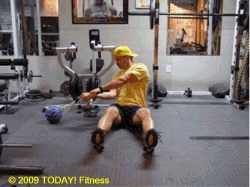
However, this
equipment in the catalogs can run over $100 for a good size
ball. I found some plans on the internet that were
super easy... here's what you'll need:
And here's what you do:
Take the basketball net out of the package
and lay it out.
Weave the shoelace in and out of the short
loops at the one end of the net.
Pull the shoelace tight and tie a couple
knots in it, clipping off the loose ends.
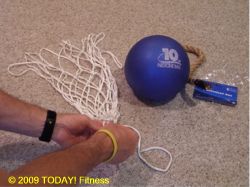
Although not really necessary, I like to
grab the loops of the other end in bunches of 3 and use a little duct
tape to bind them together about 1.5" from the top.
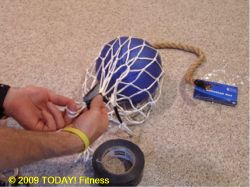
This makes it easier when you thread your rope or strap through which
is the final step after you put the ball in.
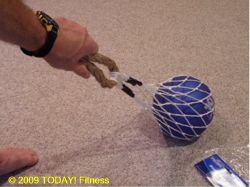
That's it... swing away!
*
Disclaimer: TODAY! Fitness does not assume any responsibility
for loss or damages if you are over anxious and decide to test this
out against the drywall in your house... and no, I didn't learn that
lesson by accident ; )
|
|
It's
Go Time! |
 O-oh say can you see.. that your
pants are too tight? Don't believe that you've failed..
with success you'll..be.. beam..ing... O-oh say can you see.. that your
pants are too tight? Don't believe that you've failed..
with success you'll..be.. beam..ing...

Ok... my sad attempt at an
independence day jingle... but you get the point! You
haven't failed until you quit trying! It's easy to
give up, to make excuses. I'm too old, I don't have
time, when the kids are back to school, when the kids are
out of school, I need to by this really cool fitness gadget,
I need to join a gym first... please, check the excuses at
the door. Whether you are trying to convince someone
else, or yourself, there is really nothing productive to
come from them. Rather than focusing your energy with
coming up with a believable excuse, put your mind to coming
up with an effective action plan.
(see the quote of the week below
; )
Reminder for my local readers
that are athletes or parents of athletes... our FREE
pre-season boot camp is scheduled to begin on Saturday, July
11th in Bear, Delaware. For more information or to
register online, visit the following link
todayfitness.net/bootcamp
.
For prior issues of this
newsletter go to
www.todayfitness.net/news.
Exceed Your
Potential!
Pete
Mazzeo, CPT
pmazzeo@todayfitness.net
"Make Time, Not Excuses"
youtube video of the month -->
Javorek Situp Routine
Romania's Olympic
weight-lifting wizard
| |